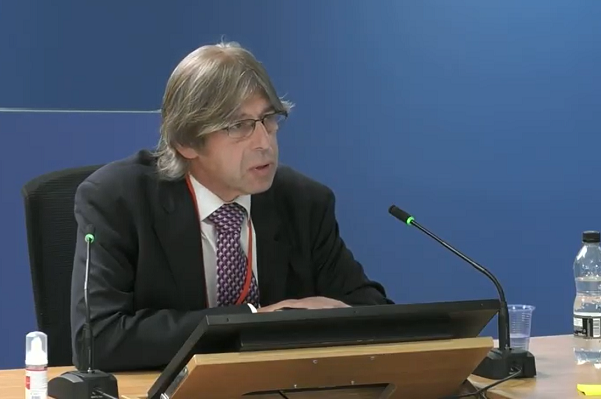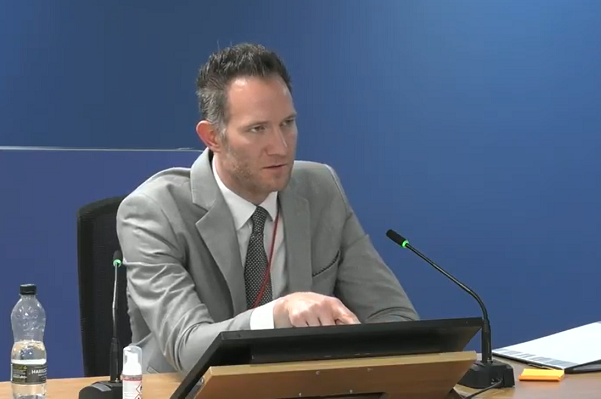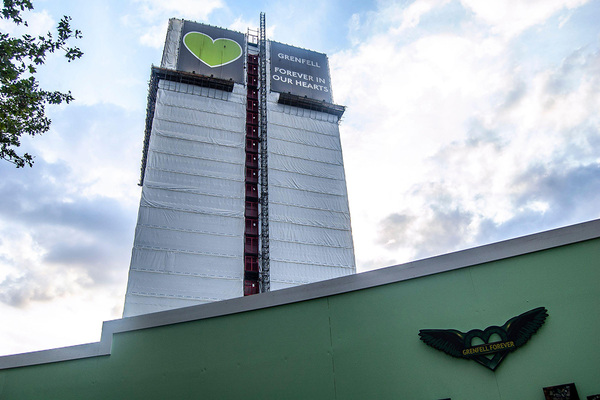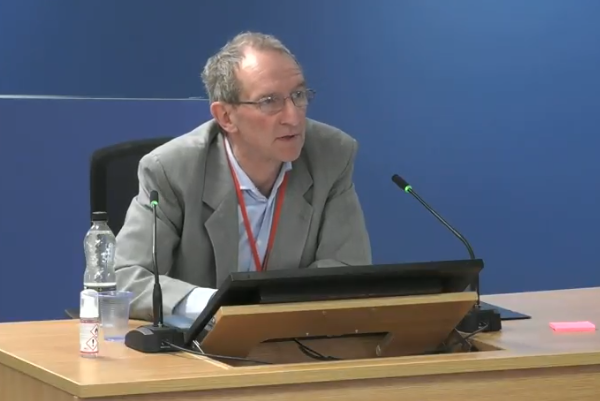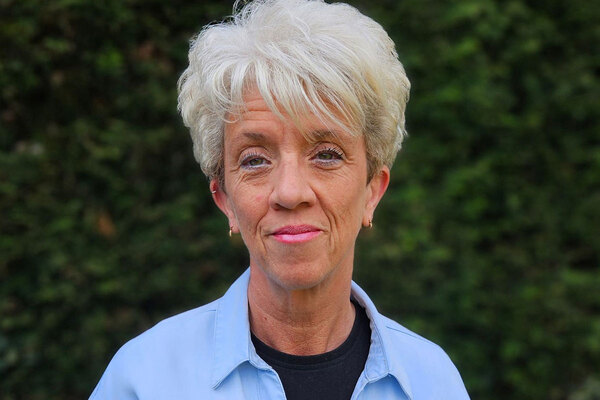Grenfell Tower Inquiry diary week 12: ‘Would you accept that was a serious failing on your part?’
With the surveyor who inspected Grenfell Tower for compliance giving evidence, this was a crucial week from the inquiry. Dominic Brady and Peter Apps report
One major question since the day of the fire has been this: why was the cladding system signed off by building control?
Over two days this week, that question was put to the person best placed to answer, surveyor John Hoban who inspected the work for the Royal Borough of Kensington and Chelsea (RBKC).
His evidence was a sorry account of cuts, overwork, limited checks and mistakes.
‘I resigned because I had enough. I wasn’t able to do the job that I was trained to do’
John Hoban’s explanation for his failures rested primarily on the pressures he was required to work under, which resulted from heavy cuts to the council’s building control service in the years building up to the tragedy.
The department was restructured to make it “self funding” in 2013 as the council looked to implement cuts across its services.
Perhaps most significantly, this involved the shut down of a ‘special projects’ team of surveyors which had previously taken on the inspection of more difficult jobs. Grenfell Tower would undoubtedly have been one of these.
Instead, all jobs were allocated through a patch system which split the west London borough up into areas. And as the number of surveyors was whittled down through retirements and one death, the patches of those remaining grew.

Grenfell Tower fell, by chance, into Mr Hoban’s patch. Despite nearly 30 years experience, he had neither the skill, experience or knowledge to deal with a high-rise overcladding. Aside from the school being built next to the tower, it was his first special project.
“It was given to you because it was in your patch regardless of your workload, and regardless of your skill and experience and regardless of your qualifications or absence of them?” asked counsel to the inquiry Richard Millett QC.
“Yes,” answered Mr Hoban.
With the number of surveyors dropping from around 12 to four or five, Mr Hoban revealed his workload would “fluctuate between 120 [and] 130 properties… plus my other duties”.
Asked about the impact this had, he said: “I wasn’t visiting certain jobs – I was making sort of judgements on who to visit, on who to write to, [in order to] sort of confirm things.”
By the end of March 2017 – just 10 weeks before the fire – Mr Hoban resigned. The pressure had become too much.
“I resigned because I had enough. I wasn’t able to do the job how I was trained to do and it was affecting my health, and I just decided that I didn’t want to work there anymore,” he said.
This picture of cuts and an overworked surveyor unable to do a thorough job was compelling, but there are a couple of caveats that are worth mentioning.
The first is why did RBKC feel the need to cut its department in the way that it did? Local authority inspectors bill the developers for their service, and there was no shortage of work. With 130 projects per surveyor, surely it would not have been difficult to secure the fees necessary to better fund the department.
Or was the truer answer that money was being filtered off to pay for services elsewhere? These are questions the inquiry may want to put to more senior members of the council, if and when they are called.
Second, Mr Hoban’s workload is not a complete excuse. Having 130 projects open sounds overwhelming, but they would not all require attention at the same time. His key mistakes, as we will see below, do not appear to have resulted simply from a lack of time.
‘I’m bound to put it to you that failure... fell below the standards of a reasonably competent building control inspector’
So what did Mr Hoban do wrong on the project?
There were numerous ways in which the surveying did not meet up to the required standard, but we will focus on three critical issues which relate directly to the fire: the cladding material, the insulation and the lack of cavity barriers.
The cladding
Mr Hoban was not initially aware that that highly combustible aluminium composite material (ACM) cladding was being planned for the tower. The design drawings he was sent in summer 2014 erroneously labelled the cladding as zinc and no one specifically told him it was being switched to ACM.
But by March 2015, he had received correctly annotated plans and some time around then (he could not recall exactly when) reviewed certification for the cladding, from independent certifier the British Board of Agrément.
This is not something he admitted to doing in his witness statement. “I just… I didn’t… all I can do is apologise,” he said.
This certificate indicated on the first page that the Reynobond ACM panels “may be regarded as having a Class 0 surface”. Under Approved Document B, Class 0 was the required standard for the external surfaces of walls – and hence cladding.
This was apparently enough for Mr Hoban. But the rest of the certificate carried a number of caveats, including a clear statement that it needed to be installed in line with instructions from the manufacturer. Mr Hoban said he never read beyond the first page.
“I don’t think I had taken any steps. I would have, as I say, the first page perhaps as, you know, it said Class 0, and maybe I didn’t read the other pages… maybe I just looked at the first page,” he said.
Had he read more, he would have realised the product came in two forms: fire rated and polyethylene cored. He did not know this and never explored whether fire rated would have been better for Grenfell Tower.
He said he had no idea what polyethylene was or how it burned. We know now that it has a similar reaction to fire as petrol.
On this point, Mr Hoban’s evidence was important in undermining an argument the government has made since the fire. Ministers have refused to accept ‘Class 0’ was the required standard for composite cladding panels, insisting that a reference to ‘filler material’ later in the guidance meant that the plastic inside the panels should have been of limited combustibility.
This has been repeatedly knocked back by industry figures who have said that the reference to filler actually meant polyfiller type products used to plug gaps in insulation. This was certainly Mr Hoban’s view.
“I didn’t understand the material inside [the cladding] to be a filler material, my understanding of filler material was to make good joints and to finish the insulation as it were,” he said.
Expect this quote to be read back to government witnesses when they eventually give evidence. The inclusion of the inadequate Class 0 standard in government guidance as the appropriate standard for cladding appears to have been a critical mistake.
The insulation
But what of the insulation? This should not have been Class 0, but the tougher standard of limited combustibility and there is no way the plastic material used on Grenfell met this standard. So why did Mr Hoban permit it?
His evidence on this point was confused. First, he said he had seen a reference on the Local Authority Building Control (LABC) website to the product – Celotex RS5000 – which described it as “suitable” for use on high rises.
But when pressed to give more detail, he could not recall whether this had in fact been the LABC website or Celotex’s own website.
Shown the product certification, he accepted that while it said it was acceptable for use on high-rise buildings, this was only the case if it was being used within a whole system that had been tested and passed. This was not the system used on Grenfell.
“You look up RS5000 on the Celotex website but you don’t get any further than seeing that it’s suitable for buildings above 18m and you don’t examine why precisely that is so. Would you accept that was a serious failing on your part?” said Mr Millett.
Mr Hoban cries as he said that he is “heartbroken” by the deaths in the fire (picture: Grenfell Inquiry)
“At the time I felt it was acceptable, but I see now that it is not,” Mr Hoban said.
He suggested that he felt reassured by the fact that fire safety consultants, Exova, were advising on the project as he felt they would ensure the plans were compliant.
But he was not aware they had in fact stopped formally advising in spring 2014. “In the discharge of your responsibilities and functions in that role [building control surveyor], are you telling us that you thought it was appropriate to rely on the presence of a fire engineer in the project?” asked Mr Millett.
“No. As I say, I just didn’t pick it up. It doesn’t register,” Mr Hoban replied.
Cavity barriers
No cavity barriers were installed around the new windows in the tower, as required by guidance, a failure which is believed to have been important in letting the flames escape the kitchen where they started so fast.
Why did Mr Hoban not notice this? The answer appears to have been that he never checked behind the window frames to see if cavity barriers were present.
Because he could see them being installed elsewhere, he effectively presumed they were being installed here as well.
“Do you accept that your failure to identify the missing cavity barriers generically around the windows on this building was a fundamental failing on your part?” asked Mr Millett.
“I should have checked. As I say, I saw the other ones and I didn’t feel it was necessary to have a window exposed [to check whether there were barriers in place],” Mr Hoban said.
“I’m bound to put it to you, Mr Hoban, that that failure to check the window openings for the presence of cavity barriers fell below the standards of a reasonably competent building control inspector. Do you accept that?” asked Mr Millett.
“As I say, in hindsight, yes, but I didn’t see it as an issue at the time,” he replied.
At the end of his evidence an openly sobbing Mr Hoban addressed the bereaved directly, telling them he was heartbroken by the deaths in the fire.
“I am truly heartbroken about what happened that night, particularly for those who lost their lives, you know, the children, the brothers and sisters, sons and daughters, fathers, mothers, grandfathers and grandmothers that lost their [lives],” he said. “I’m truly heartbroken for them.”
The clerk of works
Monday saw Gurpal Virdee, managing partner at John Rowan and Partners (JRP), the firm enlisted by Kensington and Chelsea Tenant Management Organisation (KCTMO) to provide a clerk of works (CoW) service, give evidence.
Much of his testimony revolved around exactly what the role of the CoW on the project, Jon White, entailed; Mr Virdee argued that JRP’s involvement was more limited than a traditional CoW role.
He told the inquiry: “A traditional clerk of works in my mind would have been on site… five days a week, and here [in contract] we have been specifically requested to attend on a one-day a week basis”. Mr Virdee contended that JRP was only instructed to carry out “site monitoring and supervisions services”.
Shown a comprehensive list of the duties of a CoW, Mr Virdee said the document was “a standard, generic lift from the Institute of Clerk of Works” and that JRP clarified later on that it would be giving only a limited service with CoWs on site just once a week.
Counsel to the inquiry Rose Grogan QC sought to understand JRP’s contribution to the project, in particular its role in ensuring building regulations were complied with.
Mr Virdee explained that he considered it to be the responsibility of RBKC’s building control to ensure compliance with building regulations and JRP would ask them that compliance was achieved. But Mr Virdee noted that due to the limited nature of JRP’s contract, it was “a matter of chance” if a JRP representative engaged with building control.
“We didn’t have a contractual relationship with them, number one, and then the practicality of it is you’re attending site once a week, if they’re there on site, you may see them, you may not, and generally what tends to happen is the contractual relationship is between the principle contractor [Rydon] and building control,” he told the inquiry.
‘I’m shocked that they weren’t installed’
Mark Osbourne gave evidence on Monday and Tuesday (picture: Grenfell Tower Inquiry)
Monday afternoon and Tuesday morning saw the turn of Osborne Berry, the construction firm that installed the cladding system on Grenfell Tower.
First up was director Mark Osborne, who was taken through the myriad failures relating to the installation of cavity barriers at the block. These barriers were required around the windows but were not installed.
Mr Osborne, also known as ‘Taff’, was shown pictures from the aftermath of the fire which showed the cavity barriers had been poorly cut, which left air gaps that should not have been there, and several instances of horizontal cavity barriers being installed vertically and back to front.
He could not explain how the cavity barriers came to be installed erroneously and stressed that installers he had employed were given clear guidance on how to install them.
Ms Grange also pressed him to explain why no ‘full fill’ vertical barriers were found on site after the fire.
“I can’t,” he said “I’m shocked that they weren’t installed. As far as I’m aware they were on the tower, because I fitted some of them myself. And I know they were on site because I unloaded them off the lorry.”
His business partner Grahame Berry, also known as ‘Bez’, appeared the day after Mr Osborne and was similarly asked to explain the inadequate workmanship around the cavity barriers. Like his partner, Mr Berry was at a loss to explain how the cavity barriers came to be so poorly installed.
“Most of the time we were always on site looking at what people are doing on various mast climbers around the building so I can’t see how it – it’s happened, but I can’t see how it would have happened,” he told the inquiry.
The inquiry got a glimpse into the work practices on the Grenfell Tower site when Ms Grange put forward an invoice from Osborne Berry to Harley Facades which showed that the contractors had received payment despite not doing any work.
The invoice said “8 men no work for 1 day machines up in air to look like working”.
Asked to explain, Mr Berry said: “I think that was a time where we had no materials on site for that particular day or so, and Rydon had a client meeting with a potential client for another building, so Harley asked us to be up in the air to look like we were working so it was like a normal building site as such, rather than people just sat downstairs doing nothing.”
Both men were made to answer difficult questions about allegations of Mr Berry’s inappropriate behaviour which included banging on windows to scare pets, telling residents the cladding was installed incorrectly and knocking on windows to ask for cups of tea.
The allegations were made in an email to Harley from Rydon’s project manager Simon O’Connor.
Both Mr Osborne and Mr Berry flatly denied the allegations and Mr Berry added: “It’s not in my nature to do this sort of stuff anyway.”
‘We came late to the party’
Mark Dixon, director of SD Plastering (SDP), the firm that installed the windows on Grenfell Tower, was next up.
Mr Dixon argued that he had been approached in April 2015 by a Rydon employee to undertake “cosmetic works in finishing off the surrounds to newly installed windows in each residential unit at the Grenfell Tower”.
He repeated a claim that his work was purely cosmetic and admitted he had not considered the fire performance of insulation materials installed around the windows and that he was unaware of guidance which required insulation to be of limited combustibility.
Mr Dixon made it clear that he expected other parties involved to have considered the compliance of various materials before he was drafted in to work on the project.
He told the inquiry: “We came late to the party, we have assumed that everybody else has already run every scenario and got it right. There’s been a lot of people involved in getting it to this stage. I don’t need to be guided any more than I’m being told, it’s an aesthetic finish, we’ve just got to close this off and make it look like it’s supposed to again around the windows.”
The inquiry was also shown various emails from Mr Dixon expressing his reluctance to be involved in the project due to the value on offer for SDP.
Grenfell Tower Inquiry: week 12 headlines
Grenfell building control inspector ‘fell below the standards of a competent inspector’
The building control surveyor working on the Grenfell Tower refurbishment did not read in full the specifications for the dangerous cladding and insulation that were put on the block before approving the products, the inquiry has heard.
Austerity measures left council inspector who approved Grenfell reviewing 130 projects at once
Austerity cuts left the building control inspector who approved Grenfell Tower “swamped” with work, reviewing 130 projects at once and dealing with complex projects he had no experience of, the inquiry heard.
Grenfell cladding contractor shocked by lack of cavity barriers
The contractor responsible for fitting the cladding system to Grenfell Tower has said he was “shocked” by the lack of vertical cavity barriers installed on the building, the inquiry has heard.
Grenfell cladding installers paid to look busy, invoice reveals
The building firm which installed the cladding system on Grenfell Tower was paid £880 to spend a day pretending to work, the inquiry into the fire heard.

